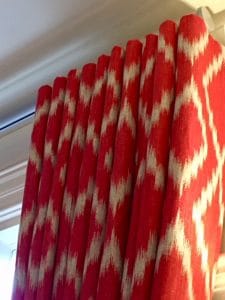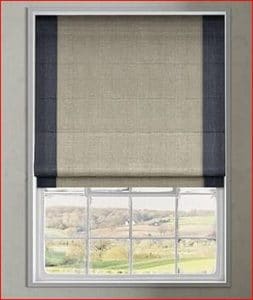How to pick fabric for curtains and blinds
How to pick fabric for curtains and blinds is a subject that confuses most of us. Faced with the huge choice of materials available it’s easy to fall in love with a few patterns, textures or colours. How is one certain it will look good when made up?
How to pick fabric for curtains and blinds is a subject that confuses most of us. Faced with the huge choice of materials available it’s easy to fall in love with a few patterns, textures or colours. How is one certain it will look good when made up?
Labels on the back of swatches showing suitability give clear information leading us to think choosing a fabric is easy. However, this only a guide and not a fail safe way to make a great choice. Much depends on the style of curtain as to which fabric gives a nicer result.
Fabric for specific headings
Common curtain heading styles such as the handmade pinch pleat or pencil pleat usually require a thinner or medium weight fabric that has ‘good draping qualities’. Look for fabrics that have a good weight or ‘handle’ and those that have good crease recovery. Scrunch up a swatch in your hand to see how much it creases and then recovers. A fabric that is too thick can be difficult to pleat. Too stiff a fabric creases too easily and looks messy. Springy or stretchy properties result in curtains billowing out towards the bottom.

Often upholstery weight fabrics are used for eyelet or wave headed curtains. The style is simpler with straighter lines demanding less flexibility. Also, for Roman blinds a thicker or upholstery weight fabric is suitable. In general, the best blind fabrics are usually tightly woven in order to keep their formal shape.



Adding interlining
Interlining is added to thinner fabrics like silk to add body to the curtain or blind that results in three layers:
- The main fabric (eg. Silk, cotton mix etc)
- A soft fluffy type fabric we call interlining. This is either a synthetic polyester or a natural cotton.
- A lining fabric which is blackout coated cotton or a non-blackout cotton or cotton/polyester mix.
A curtain consultant is able to advise you whether or not a curtain fabric would benefit from being interlined. The added middle layer makes them thicker and makes them more thermally efficient. Interlining also makes curtains and blinds heavier. Well fixed , robust tracks and poles are required to hold them up.

Ask a professional
An experienced curtain professional would be able to take an educated guess as to what fabrics would make successful curtains and blinds in a specific situation. They can also advise on possible fading and shrinkage issues. However, they cannot know the exact properties of every fabric as there are millions on the market all with different compositions, weaves, qualities and finishes. One can get a good idea of fabric suitability by holding up a larger piece and seeing how nicely it falls.
Fabric companies are able to provide larger returnable samples. However, unless one has experience of using a certain fabric for an exact purpose you could be never entirely sure of how it will hang in a large area. Due to differing weaving, finishing and printing processes furnishing fabrics are full of surprises.
Taking a little risk is normal practice because chances are, you have fallen in love with a fabric for whatever reason and nothing else will take its place. Considering the expense incurred in commissioning made to measure window treatments, it pays to try to get it right. There are also hardware and space issues to consider. For the best advice on how to pick a fabric for curtains and blinds contact an experienced maker.


